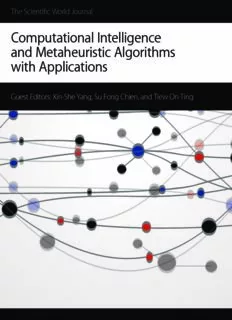Table Of ContentThe Scientific World Journal
Computational Intelligence
and Metaheuristic Algorithms
with Applications
Guest Editors: Xin-She Yang, Su Fong Chien, and Tiew On Ting
Computational Intelligence and Metaheuristic
Algorithms with Applications
The Scientific World Journal
Computational Intelligence and Metaheuristic
Algorithms with Applications
Guest Editors: Xin-She Yang, Su Fong Chien,
and Tiew On Ting
Copyright©2014HindawiPublishingCorporation.Allrightsreserved.
Thisisaspecialissuepublishedin“TheScientificWorldJournal.”AllarticlesareopenaccessarticlesdistributedundertheCreativeCom-
monsAttributionLicense,whichpermitsunrestricteduse,distribution,andreproductioninanymedium,providedtheoriginalworkis
properlycited.
Contents
ComputationalIntelligenceandMetaheuristicAlgorithmswithApplications,Xin-SheYang,
SuFongChien,andTiewOnTing
Volume2014,ArticleID425853,4pages
GeneNetworkBiologicalValidityBasedonGene-GeneInteractionRelevance,
FranciscoGo´mez-VelaandNorbertoD´ıaz-D´ıaz
Volume2014,ArticleID540679,11pages
ComparingEvolutionaryStrategiesonaBiobjectiveCulturalAlgorithm,CarolinaLagos,
BroderickCrawford,EnriqueCabrera,RicardoSoto,Jose´-MiguelRubio,andFernandoParedes
Volume2014,ArticleID745921,10pages
TowardsEnhancementofPerformanceofK-MeansClusteringUsingNature-InspiredOptimization
Algorithms,SimonFong,SuashDeb,Xin-SheYang,andYanZhuang
Volume2014,ArticleID564829,16pages
CongestionControlforaFairPacketDeliveryinWSN:FromaComplexSystemPerspective,
DanielaAguirre-Guerrero,RicardoMarcel´ın-Jime´nez,EnriqueRodriguez-Colina,andMichael
Pascoe-Chalke
Volume2014,ArticleID381305,12pages
AVariableNeighborhoodWalksat-BasedAlgorithmforMAX-SATProblems,NoureddineBouhmala
Volume2014,ArticleID798323,11pages
TuningofKalmanFilterParametersviaGeneticAlgorithmforState-of-ChargeEstimationinBattery
ManagementSystem,T.O.Ting,KaLokMan,EngGeeLim,andMarkLeach
Volume2014,ArticleID176052,11pages
ImprovedBatAlgorithmAppliedtoMultilevelImageThresholding,AdisAlihodzicandMilanTuba
Volume2014,ArticleID176718,16pages
FocusingontheGoldenBallMetaheuristic:AnExtendedStudyonaWiderSetofProblems,E.Osaba,
F.Diaz,R.Carballedo,E.Onieva,andA.Perallos
Volume2014,ArticleID563259,17pages
MultiobjectiveMemeticEstimationofDistributionAlgorithmBasedonanIncrementalTournament
LocalSearcher,KaifengYang,LiMu,DongdongYang,FengZou,LeiWang,andQiaoyongJiang
Volume2014,ArticleID836272,21pages
NullSteeringofAdaptiveBeamformingUsingLinearConstraintMinimumVarianceAssistedby
ParticleSwarmOptimization,DynamicMutatedArtificialImmuneSystem,andGravitationalSearch
Algorithm,SoodabehDarzi,TiongSiehKiong,MohammadTariqulIslam,MahamodIsmail,
SalehinKibria,andBalasemSalem
Volume2014,ArticleID724639,10pages
ACuckooSearchAlgorithmforMultimodalOptimization,ErikCuevasandAdolfoReyna-Orta
Volume2014,ArticleID497514,20pages
MACProtocolforAdHocNetworksUsingaGeneticAlgorithm,OmarElizarraras,MarcoPanduro,
AldoL.Me´ndez,andAlbertoReyna
Volume2014,ArticleID670190,9pages
AnAntColonyOptimizationBasedFeatureSelectionforWebPageClassification,
EsraSarac¸andSelmaAy¸seO¨zel
Volume2014,ArticleID649260,16pages
ReinforcementLearningforRoutinginCognitiveRadioAdHocNetworks,HasanA.A.Al-Rawi,
Kok-LimAlvinYau,HafizalMohamad,NordinRamli,andWahidahHashim
Volume2014,ArticleID960584,22pages
FeaturesExtractionofFlotationFrothImagesandBPNeuralNetworkSoft-SensorModelof
ConcentrateGradeOptimizedbyShuffledCuckooSearchingAlgorithm,Jie-shengWang,ShuangHan,
Na-naShen,andShu-xiaLi
Volume2014,ArticleID208094,17pages
ANovelUserClassificationMethodforFemtocellNetworkbyUsingAffinityPropagationAlgorithm
andArtificialNeuralNetwork,AfazUddinAhmed,MohammadTariqulIslam,MahamodIsmail,
SalehinKibria,andHaslinaArshad
Volume2014,ArticleID253787,14pages
ASynchronous-AsynchronousParticleSwarmOptimisationAlgorithm,NorAzlinaAbAziz,
MarizanMubin,MohdSaberiMohamad,andKamarulzamanAbAziz
Volume2014,ArticleID123019,17pages
GaitSignalAnalysiswithSimilarityMeasure,SanghyukLeeandSeungsooShin
Volume2014,ArticleID136018,8pages
AnImprovedAntColonyOptimizationApproachforOptimizationofProcessPlanning,JinFengWang,
XiaoLiangFan,andHaiminDing
Volume2014,ArticleID294513,15pages
IntegratedModelofMultipleKernelLearningandDifferentialEvolutionforEUR/USDTrading,
ShangkunDengandAkitoSakurai
Volume2014,ArticleID914641,12pages
ADistributedParallelGeneticAlgorithmofPlacementStrategyforVirtualMachinesDeploymenton
CloudPlatform,Yu-ShuangDong,Gao-ChaoXu,andXiao-DongFu
Volume2014,ArticleID259139,12pages
AnArtificialBeeColonyAlgorithmforUncertainPortfolioSelection,WeiChen
Volume2014,ArticleID578182,12pages
FaultDetectionofAircraftSystemwithRandomForestAlgorithmandSimilarityMeasure,Sanghyuk
Lee,WookjePark,andSikhangJung
Volume2014,ArticleID727359,7pages
AdaptiveMANETMultipathRoutingAlgorithmBasedontheSimulatedAnnealingApproach,
SungwookKim
Volume2014,ArticleID872526,8pages
ASolutionQualityAssessmentMethodforSwarmIntelligenceOptimizationAlgorithms,
ZhaojunZhang,Gai-GeWang,KuanshengZou,andJianhuaZhang
Volume2014,ArticleID183809,8pages
ApplicationofReinforcementLearninginCognitiveRadioNetworks:ModelsandAlgorithms,
Kok-LimAlvinYau,Geong-SenPoh,SuFongChien,andHasanA.A.Al-Rawi
Volume2014,ArticleID209810,23pages
FireflyAlgorithmforCardinalityConstrainedMean-VariancePortfolioOptimizationProblemwith
EntropyDiversityConstraint,NebojsaBacaninandMilanTuba
Volume2014,ArticleID721521,16pages
CuckooSearchwithLe´vyFlightsforWeightedBayesianEnergyFunctionalOptimizationin
Global-SupportCurveDataFitting,AkemiGa´lvez,Andre´sIglesias,andLuisCabellos
Volume2014,ArticleID138760,11pages
PSO-BasedSupportVectorMachinewithCuckooSearchTechniqueforClinicalDiseaseDiagnoses,
XiaoyongLiuandHuiFu
Volume2014,ArticleID548483,7pages
AnIslandGroupingGeneticAlgorithmforFuzzyPartitioningProblems,S.Salcedo-Sanz,J.DelSer,
andZ.W.Geem
Volume2014,ArticleID916371,15pages
OntheEffectivenessofNature-InspiredMetaheuristicAlgorithmsforPerformingPhaseEquilibrium
ThermodynamicCalculations,Seif-EddeenK.FateenandAdrianBonilla-Petriciolet
Volume2014,ArticleID374510,12pages
CloudModelBatAlgorithm,YongquanZhou,JianXie,LiangliangLi,andMingzhiMa
Volume2014,ArticleID237102,11pages
EvolutionaryMultiobjectiveQueryWorkloadOptimizationofCloudDataWarehouses,
TanselDokeroglu,SeyyitAlperSert,andMuhammetSerkanCinar
Volume2014,ArticleID435254,16pages
AnInvestigationofGeneralizedDifferentialEvolutionMetaheuristicforMultiobjectiveOptimal
Crop-MixPlanningDecision,OluwoleAdekanmbi,OludayoOlugbara,andJosiahAdeyemo
Volume2014,ArticleID258749,8pages
TowardstheNovelReasoningamongParticlesinPSObytheUseofRDFandSPARQL,IztokFisterJr.,
Xin-SheYang,KarinLjubicˇ,DuˇsanFister,JanezBrest,andIztokFister
Volume2014,ArticleID121782,10pages
SupportVectorMachineBasedonAdaptiveAccelerationParticleSwarmOptimization,
MohammedHasanAbdulameer,SitiNorulHudaSheikhAbdullah,andZulaihaAliOthman
Volume2014,ArticleID835607,8pages
NovelBackPropagationOptimizationbyCuckooSearchAlgorithm,Jiao-hongYi,Wei-hongXu,
andYuan-taoChen
Volume2014,ArticleID878262,8pages
Hindawi Publishing Corporation
e Scientific World Journal
Volume 2014, Article ID 425853, 4 pages
http://dx.doi.org/10.1155/2014/425853
Editorial
Computational Intelligence and Metaheuristic
Algorithms with Applications
Xin-SheYang,1SuFongChien,2andTiewOnTing3
1SchoolofScienceandTechnology,MiddlesexUniversity,LondonNW44BT,UK
2StrategicAdvancedResearch(StAR),MathematicalModelingLab,MIMOSBerhad,TechnologyParkMalaysia,
KualaLumpur,Malaysia
3DepartmentofElectricalandElectronicEngineering,Xi’anJiaotong-LiverpoolUniversity,No.111Ren’aiRoad,
HET,SIP,Suzhou,Jiangsu215123,China
CorrespondenceshouldbeaddressedtoXin-SheYang;x.yang@mdx.ac.uk
Received4August2014;Accepted4August2014;Published31December2014
Copyright©2014Xin-SheYangetal.ThisisanopenaccessarticledistributedundertheCreativeCommonsAttributionLicense,
whichpermitsunrestricteduse,distribution,andreproductioninanymedium,providedtheoriginalworkisproperlycited.
1.Introduction inmimickingnaturalsystems[1,2].Consequently,different
algorithmsmayhavedifferentfeaturesandthusmaybehave
Nature-inspiredmetaheuristicalgorithmshavebecomepow- differently, even with different efficiencies. However, It still
erful and popular in computational intelligence and many lacksin-depthunderstandingwhythesealgorithmsworkwell
applications. There are some important developments in andexactlyunderwhatconditions,thoughthereweresome
recent years, and this special issue aims to provide a timely goodstudiesthatmayprovideinsightintoalgorithms[2,8].
review of such developments, including ant colony opti- Thisspecialissuefocusesontherecentdevelopmentsof
mization,batalgorithm,cuckoosearch,particleswarmopti- SI-based metaheuristic algorithms and their diverse appli-
mization,geneticalgorithms,supportvectormachine,neural cations as well as theoretical studies. Therefore, this paper
networks,andothers.Inaddition,thesealgorithmshavebeen is organized as follows. Section2 provides an introduction
appliedinadiverserangeofapplications,andsomeofthese and comparison of the so-called infinite monkey theorem
latestapplicationsarealsosummarizedhere. and metaheuristics, followed by the brief review of compu-
Computationalintelligenceandmetaheuristicalgorithms tational intelligence and metaheuristics in Section3. Then,
havebecomeincreasinglypopularincomputerscience,arti- Section4 touches briefly the state-of-the-art developments,
ficialintelligence,machinelearning,engineeringdesign,data and finally, Section5 provides some open problems about
mining, image processing, and data-intensive applications. some key issues concerning computational intelligence and
Mostalgorithmsincomputationalintelligenceandoptimiza- metaheuristics.
tionarebasedonswarmintelligence(SI)[1,2].Forexample,
bothparticleswarmoptimization[1]andcuckoosearch[3]
2.Monkeys,Shakespeare,andMetaheuristics
have attracted much attention in science and engineering.
Theybothcaneffectivelydealwithcontinuousproblems[2] Thereisawell-knownthoughtexperiment,calledtheinfinite
and combinatorial problems [4]. These algorithms are very monkey theorem, which states that the probability of pro-
differentfromtheconventionalevolutionaryalgorithmssuch ducinganygiventextwillalmostsurelybeoneifaninfinite
as genetic algorithms and simulated annealing [5, 6] and numberofmonkeysrandomlytypeforaninfinitelylongtime
otherheuristics[7]. [9,10].Inotherwords,theinfinitemonkeyscanbeexpected
Manynewoptimizationalgorithmsarebasedontheso- toreproducethewholeworksofShakespeare.Forexample,
called swarm intelligence (SI) with diverse characteristics to reproduce the text “swarm intelligence” (18 characters
2 TheScientificWorldJournal
including the space), for a random typing sequence of 𝑛 methods,anddataminingtechniquesareallwellestablished,
charactersona101-keycomputerkeyboard,theprobabilityof though constant improvements and refinements are being
aconsecutive18-characterrandomstringtobe“swarmintel- carriedout.Forexample,neuralnetworksandsupportvector
ligence”is𝑝𝑠 = (1/101)18 ≈ 8.4×10−37,whichisextremely machineshavebeenaroundforafewdecades,andtheyhave
small.However,theimportancehereisthatthisprobability beenappliedtoalmosteveryareaofscienceandengineering
is not zero. Therefore, for an infinitely long sequence 𝑛 → [12, 13]. However, it was mainly in the 1990s when these
∞, the probability of reproducing the collected works of twomethodsbecametrulypopular,whenthemasscomputer
Shakespeareisone,thoughtheformalrigorousmathematical facilities become affordable with the steady increase of the
analysisrequiresBorel-Cantellilemma[9,11]. computationalspeed.
Conversely, we can propose a finite monkey theorem Nowadayscomputationalintelligencehaspermeatedinto
withoutproof.Foragivenfinitenumberofmonkeystyping manyapplicationsdirectlyorindirectly.Accompanyingthis
for a fixed amount of time, what is the probability of expansion,nature-inspiredmetaheuristicalgorithmsbeginto
reproducinganypieceoftextsuchasthispaper? demonstratepromisingpowerincomputationalintelligence
In many ways, heuristic and metaheuristic algorithms and many other areas [14]. For example, cuckoo search has
havesomesimilaritiestotheinfinitemonkeyapproach.Mon- been used in optimizing truss structures [15] and other
keystyperandomlyand,ultimately,somemeaningfulhigh- applications[3],whileahybridapproachcombiningatwo-
qualitytextmayappear.Similarly,moststochasticalgorithms stage eagle strategy with differential evolution can save
use randomization to increase the search capability. If such computational efforts [16]. New algorithms emerge almost
algorithms are executed for a sufficiently long time with everyyearwithatrendofspeedup.
multiple runs, it can be expected that the global optimality Algorithmswhichappearedinthelastfiveyearsinclude
of a given problem can be reached or found. In theory, it bat algorithm [17], cuckoo search [3], flower pollination
may take infinitely long to guarantee such optimality, but, algorithm [18], and others, which are in addition to the
in practice, it can take many thousands or even millions of popularandwell-acceptedalgorithmssuchasparticleswarm
iterations.Ifweconsidertheoptimalityasanimportantpiece optimization,antcolonyoptimization,fireflyalgorithm,dif-
ofworkofShakespeare,theinfinitemonkeysshouldbeable ferential evolution, and genetic algorithms. Different algo-
toreproduceorachieveitinaninfiniteamountoftime. rithms have different sources of inspiration, and they can
However, there are some key differences between the also perform differently [1, 2]. For example, among most
heuristicalgorithmsandtheinfinitemonkeyapproach.First, recent,bioinspiredalgorithms,flowerpollinationalgorithm
monkeys randomly type without any memory or learning (FPA),orfloweralgorithm(FA)forsimplicity,wasdeveloped
processing, and each key input is independent of another. by Xin-She Yang, which has demonstrated very good effi-
Heuristic algorithms try to learn from history and the past ciencyinsolvingbothsingleoptimizationandmultiobjective
moves so as to generate new, better moves or solutions optimization problems [18]. Both the flower algorithm and
[7]. Second, random monkeys do not select what has been the cuckoo search use more subtle Le´vy flights instead of
typed, while algorithms try to select the best solutions or standardGaussianrandomwalks[19].
thefittestsolutions[5].Third,monkeysusepurelystochastic However,someefficientapproachescanbebasedonthe
components, while all heuristic algorithms use both deter- combinationofdifferentalgorithms,andtheeaglestrategyis
ministicandstochasticcomponents.Finally,monkeytyping atwo-stagestrategycombiningacoarseexplorativestageand
atmostisequivalenttoarandomsearchonaflatlandscape, anintensiveexploitativestageinaniterativemanner[16].
while heuristic algorithms are often cleverly constructed to
Applications can be very diverse, from structural opti-
use the landscape information in combination with history
mization [15] to energy efficient telecommunications [20].
(memory) and selection. All these differences ensure that
Detailed list of applications can be found in recent review
heuristicalgorithmsarefarbetterthantherandommonkey-
articles[3,17]orbooks[2].
typingapproach.
In addition, metaheuristics are usually considered as a
4.State-of-the-ArtDevelopments
higher level of heuristics, because metaheuristic algorithms
arenotsimpletrial-and-errorapproachesandmetaheuristics
Asthedevelopmentsareactiveandextensive,itisnotpossible
aredesignedtolearnfrompastsolutions,tobebiasedtowards
tocoveragoodpartoftherecentadvancesinasinglespecial
better moves, to select the best solutions, and to construct
issue.Therefore,thisspecialissuecanonlyprovideatimely
sophisticatedsearchmoves.Therefore,metaheuristicscanbe
snapshotofthestate-of-the-artdevelopments.Theresponses
muchbetterthanheuristicalgorithmsandcandefinitelybe
tothisspecialissuewereoverwhelming,andmorethan100
farmoreefficientthanrandommonkey-typingapproaches.
submissionswerereceived.Aftergoingthroughtherigorous
peer-review process, 32 papers have been accepted for this
3.ComputationalIntelligence issue.Abriefsummaryofthesepapersisgivenbelow.
andMetaheuristics E. Cuevas et al. provide a study of multimodal opti-
mizationusingthecuckoosearchalgorithm,whileE.Sarac¸
Computational intelligence has been in active development and S. A. O¨zel carry out web page classification using ant
for many years. Classical methods and algorithms such colony optimization and O. Elizarraras et al. obtain better
as machine learning methods, classifications and cluster performanceinadhocnetworkusinggeneticalgorithms.In
Description:On the Effectiveness of Nature-Inspired Metaheuristic Algorithms for They act as a bridge .. The left column in the figure represents the study

